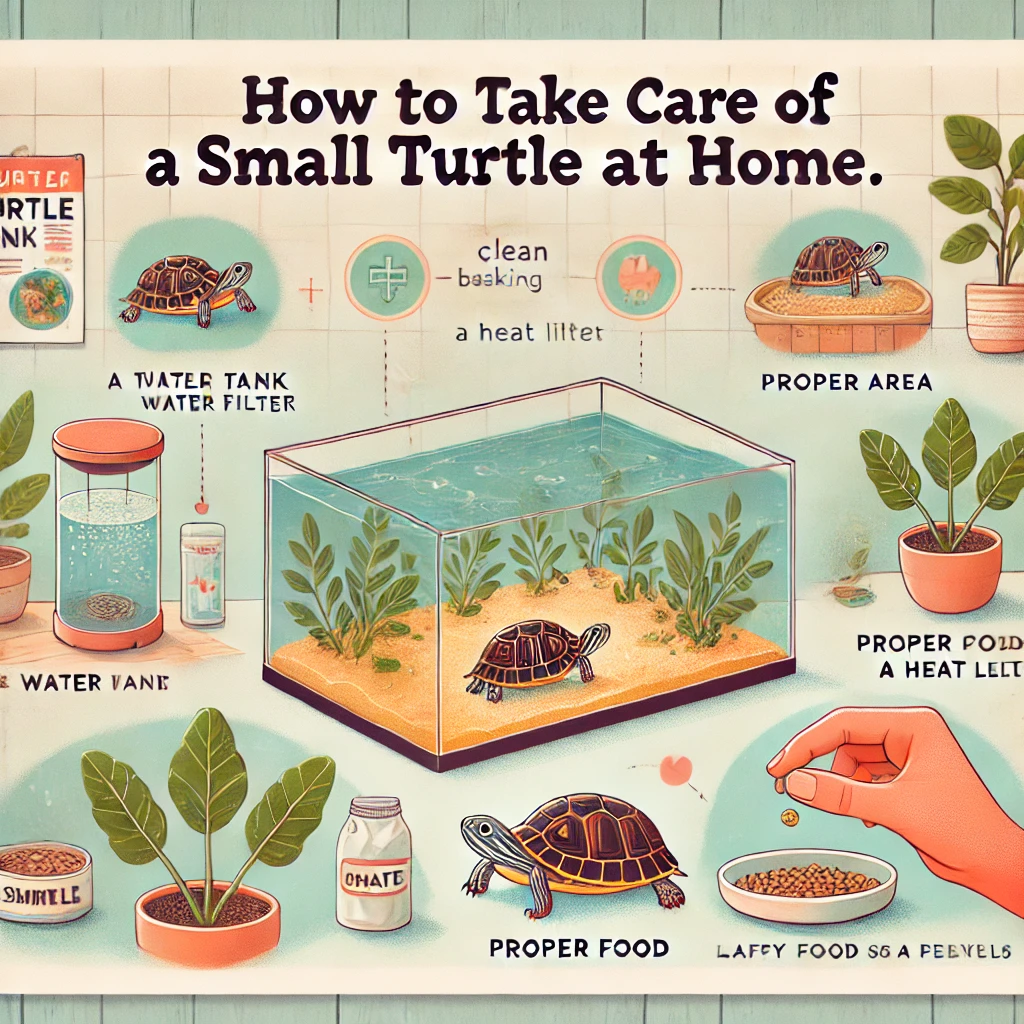
Learn how to care for a small pet turtle at home with expert tips on habitat setup, diet, lighting, and health care for a happy and thriving pet turtle.
Introduction
Turtles make fascinating and low-maintenance pets, but they still require proper care and attention to thrive. Whether you have a baby turtle or a small adult, understanding their habitat, diet, and health needs is essential. A well-cared-for turtle can live for decades, becoming a long-term companion. In this guide, we’ll explore everything you need to know about caring for a small turtle at home, from setting up the perfect environment to ensuring they stay healthy and active.
Setting Up the Ideal Pet Turtle Habitat
1- Choosing the Right Tank or Enclosure
A small turtle may not need a massive space initially, but as it grows, it will require a larger tank. Here’s what to consider:
- Tank Size: A minimum of a 20-gallon tank is recommended for a small turtle, but a 40-gallon tank or larger is ideal for long-term care.
- Water for Aquatic Turtles: Ensure the water depth is at least twice the length of the turtle’s shell so they can swim freely.
- Basking Area: Provide a dry, elevated surface using rocks, platforms, or floating docks where the pet turtle can rest and absorb heat.
2- Maintaining Proper Temperature and Lighting
Turtles are ectothermic, meaning they rely on external sources to regulate their body temperature. To keep them comfortable:
- Water Temperature: Maintain between 75-85°F (24-29°C) using an aquarium heater.
- Basking Temperature: A heat lamp should warm the basking area to 85-95°F (29-35°C).
- UVB Lighting: Turtles need 10-12 hours of UVB light daily to absorb calcium and prevent metabolic bone disease. Use a UVB bulb specifically designed for reptiles.
3- Feeding Your Small Turtle Properly
Turtles have different dietary needs depending on their species. However, most small pet turtles are omnivores, requiring a mix of animal and plant-based foods.
Are Ferrets Good Pets? A Complete Guide for Potential Owners
What to Feed Your Turtle
- Turtle Pellets: The main staple diet, providing essential nutrients.
- Leafy Greens: Offer kale, collard greens, romaine lettuce, and dandelion greens.
- Protein Sources: Small portions of cooked fish, earthworms, crickets, or shrimp.
- Fruits: Feed sparingly—small pieces of banana, apple, or berries as an occasional treat.
Feeding Schedule
- Baby turtles: Feed daily with a mix of protein and vegetables.
- Adult turtles: Feed every other day with a focus on plant-based foods.
- Avoid overfeeding: Overeating can lead to obesity and shell deformities. Remove any uneaten food to prevent water contamination.
Keeping Your Turtle’s Tank Clean
A clean habitat is crucial for your turtle’s health. Dirty water can lead to bacterial infections and unpleasant odors.
How to Maintain a Clean Tank
- Use a Strong Filter: A canister or submersible filter helps keep the water clear.
- Perform Regular Water Changes: Replace 25% of the water weekly and do a full water change monthly.
- Remove Debris Daily: Leftover food, waste, and algae should be cleaned regularly.
Handling and Interacting with Your Turtle
While turtles are not as interactive as dogs or cats, they can recognize their owners and respond to feeding time.
Best Practices for Handling
- Wash Your Hands Before and After Handling: Turtles carry Salmonella bacteria, so proper hygiene is essential.
- Limit Handling: Too much handling can stress your turtle. Let them approach you during feeding time.
- Observe Their Behavior: If your turtle frequently hides, is lethargic, or refuses food, it may be a sign of illness.
Common Turtle Health Issues and Prevention
If not properly cared for, pet turtles can suffer from several health conditions. Here are some common issues and ways to prevent them.
Shell Rot
- Symptoms: Soft, discolored, or flaky shell spots.
- Prevention: Maintain a clean tank and provide proper UVB lighting.
Respiratory Infections
- Symptoms: Wheezing, open-mouth breathing, nasal discharge.
- Prevention: Keep water at the right temperature and avoid cold drafts.
Vitamin Deficiencies
- Symptoms: Swollen eyes, soft shell, weak limbs.
- Prevention: Provide a UVB lamp and a calcium-rich diet with cuttlebone supplements.
If you notice severe symptoms, consult a reptile veterinarian immediately.
Conclusion
Caring for a small turtle at home requires commitment, but with the right habitat, diet, and cleanliness, they can thrive for many years. By following these care tips, you’ll ensure your turtle stays healthy, happy, and active.
Frequently Asked Questions (FAQs)
Can I keep a small turtle in a fish tank?
Yes, but make sure the tank is large enough, has a basking area, and includes a powerful filter to keep the water clean.
How often should I clean my turtle’s tank?
Perform a partial water change weekly and a full tank cleaning monthly to maintain a healthy environment.
What is the best temperature for a small turtle’s tank?
The water should be 75-85°F (24-29°C), and the basking area should be 85-95°F (29-35°C).
How long can a small turtle go without eating?
A healthy adult turtle can go up to 2 weeks without food, but baby turtles should not go more than a few days without eating.
Do turtles need company?
Most turtles are solitary and do not need tank mates. However, some species may become aggressive toward others, so it is often best to keep them alone.
How long do small pet turtles live?
Depending on the species, pet turtles can live 20-50 years or more with proper care.


